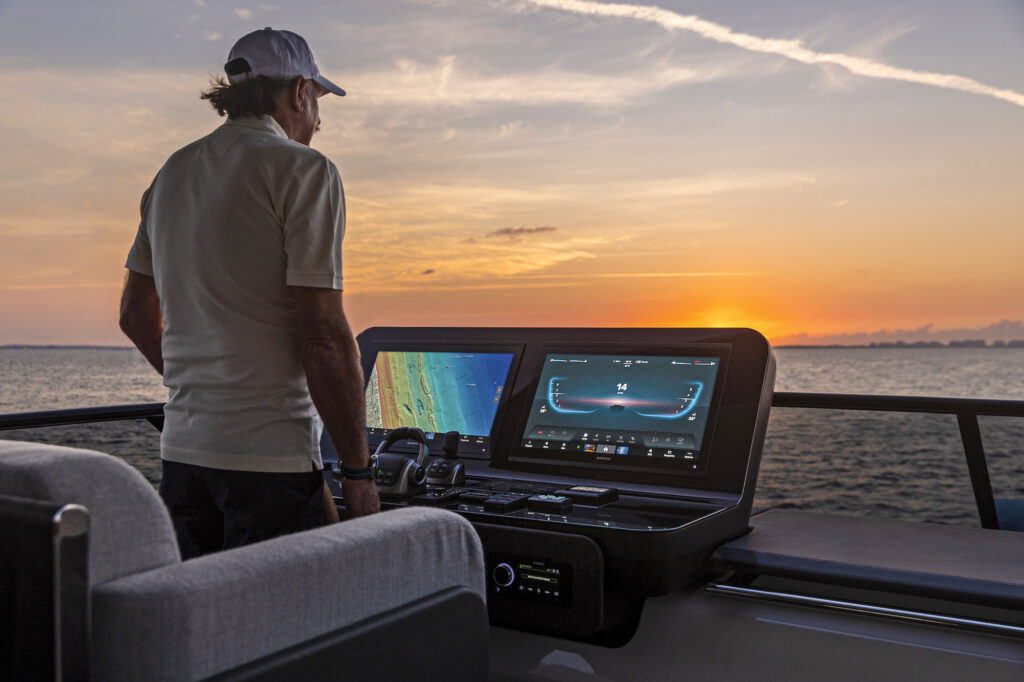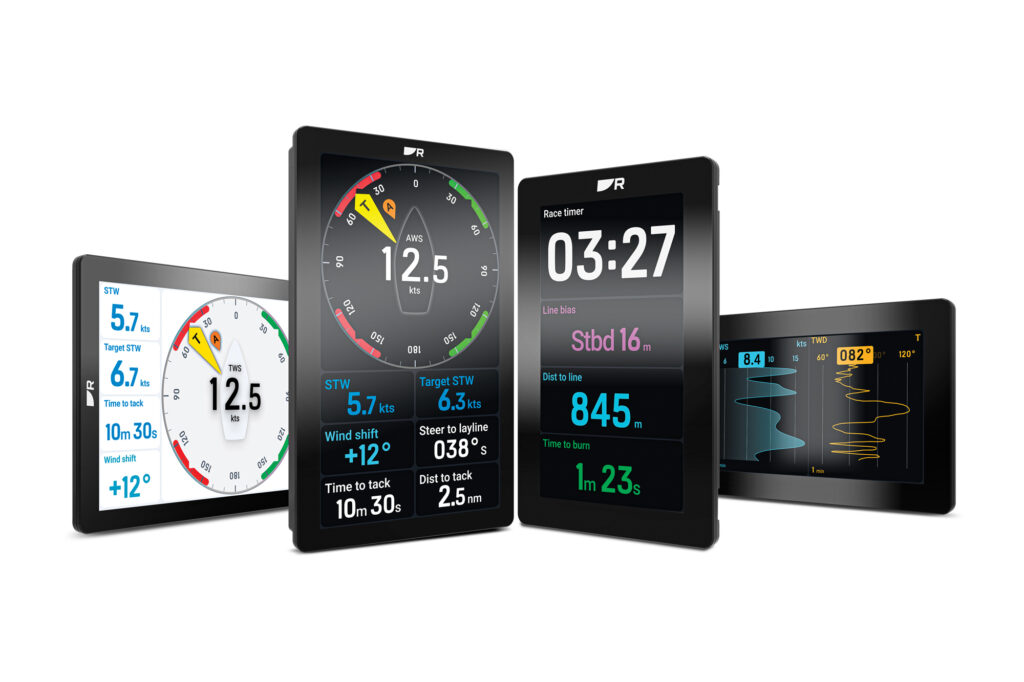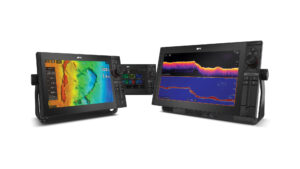
The fall and winter boat shows mean that an armada of technology is being launched to make everyone’s time on the water safer and more fun. Without further ado, here is some of the top tech to put on your radar for the new year’s boating season.
Garmin
Innovations in marine electronics hail from two places: hardware and software. In recent years, hardware advances have slowed compared with a decade ago. Case in point: While Garmin has long pushed the software envelope, the company’s flagship multifunction display—the GPSMap 8400/8600—premiered in 2016. Garmin’s newest flagship display, the GPSMap 9000 series ($9,900 to $17,000), brings significant hardware advances.
These advances include edge-to-edge 4K displays, processors that purportedly deliver seven times the speed of Garmin’s previous offerings, and a faster local network (Garmin BlueNet gigabit network, which can hustle data at up to 1 gigabit per second to and from peripherals, including radar and sonar modules).
GPSMap 9000-series displays are available in 19-, 22-, 24-, and 27-inch screens that ship with Navionics+ cartography and AutoGuidance+ routing. The displays also support engine-room monitoring, Garmin’s OneHelm integrated digital switching, and Garmin’s Surround View Camera System, which eases the challenges of docking. Users can control these IPX7-rated displays via a touchscreen interface, with voice commands using a headset (sold separately) or with a paired Garmin smartwatch (also sold separately).
Speaking of peripherals, Garmin also unveiled its GSD 28 sonar module, which is a dual-channel Xchirp-enabled black-box sonar that can probe depths to 10,000 feet. The GSD 28 ($3,000) can be networked to Airmar- or Garmin-built transducers, and can transmit at 300 watts to 3 kilowatts. The sonar has Garmin’s Rapidreturn, which delivers two to six times faster ping rates than previous-generation black-box sonar. Boaters who cruise with Garmin’s MSC 10 satellite compasses can also leverage the GSD 28’s Heave Compensation feature, which removes vessel motion from its returns.
Furuno
Integration has long been a marine-electronics buzzword, but Furuno took a different tack with its FCV-600 and FCV-800 stand-alone fish finders. The sounders (call for pricing) have chirp and dual-frequency (50/200 kilohertz) capabilities, and they can explore depths to 3,937 feet.
The FCV-600 has 5.7 inches of screen real estate and transmits at 600 watts, while the FCV-800 has 8.4 inches of glass and transmits at 1 kilowatt. Additionally, the FCV-800 cooperates with NMEA 2000 and NMEA 0183 networks, while the FCV-600 uses only N2K networks.
Both fish finders are compatible with a range of transducers, and both support Furuno’s proprietary fish-finding technologies, including RezBoost signal processing, Bottom Discrimination and TruEcho Chirp, which yields better image resolution and onscreen target separation than traditional 50/200 kHz sounders. Also, both fish finders are Wi-Fi-enabled, which lets one fish finder communicate wirelessly with another identical sounder. In other words, two FCV-600s can talk, or one can communicate with select third-party apps and smartphones.

Raymarine
Sailors love wind information. Raymarine’s Alpha Series Displays and RSW Series Wind Sensors capture and present data that is user-customizable.
Alpha displays ($1,200 to $2,000) come in 7- and 9-inch screens that can be mounted vertically or horizontally at the mast or the helm. Users can customize screen views, and they can control the displays via the individual touchscreens or through networked Raymarine-built Axiom multifunction displays.
RSW Series Wind Sensors ($850) are self-calibrating, with embedded attitude-heading-reference-system sensors that measure pitch, roll and yaw. This combination allows the system to calculate true-wind metrics and present them on an Alpha Series Display.
VoltSafe
From a distance, the smartest thing about VoltSafe is the magnetic connection between an ordinary 30-amp shore-power cable and VoltSafe’s proprietary charging station. Should someone forget to disconnect before engaging the boat’s throttles, 40 pounds of load breaks the magnetic connection.
Better still, VoltSafe’s shoreside chargers use an electronic vetting process (think electric-car chargers) with the reciprocal magnetic connector. If the connection doesn’t pass muster, electricity stops (or never starts) flowing. This feature adds a significant safety margin, especially given the presence of water.
While VoltSafe systems are currently a marina-facing product, in time, users will be able to communicate with the system via VoltSafe’s app. This feature should be useful for tracking bills, tracing low-voltage issues, and receiving power-outage alerts.
OceanLED
Lighting can help set a mood, but controlling belowdecks, topside and undercarriage illuminators can be challenging. OceanLED’s OceanBridge (call for pricing) is a multizone control system that can be driven from a networked multifunction display via an NMEA 2000 or Ethernet connection, or from a smart device using OceanBridge’s built-in Wi-Fi connectivity.
OceanBridge systems can control all OceanLED lights, plus most third-party DC-powered lights. In total, the system can control 64 lights (this can be expanded to 150-plus with splitters), including color and brightness, color fades and transitions. There’s also music sync and OceanLED’s proprietary movement-to-color feature across 10 zones.
Digital Yacht
Devices enabled for the internet are handy, but they can open the door to hackers. Digital Yacht’s N2K Protect ($350) stops onboard cyberthreats by validating all equipment on an NMEA 2000 network.
After that, N2K Protect creates a baseline network map, which it stores locally. N2K Protect locks down and monitors the network 24/7/365. Users can configure the system to generate an alarm (N2K network alerts or SMS messages via a Digital Yacht 4G/5G cellular modem) if unscrupulous activity or poor N2K performance is detected. And N2K Protect is updatable via an embedded web interface.
Digital Yacht also recently unveiled its CO Alert carbon-monoxide detection and alarm system. CO Alert ($330) is a two-piece system consisting of a white-box detection sensor and a black box that tackles power supply and network connectivity. The low-draw system constantly monitors its self-test feature to ensure safety and performance. If tripped, the system generates audio and visual alarms on NMEA 2000-networked multifunction displays.
Actisense
NMEA 2000 networks move a lot of information. Actisense’s NGX-1 gateway helps boaters access this data.
Actisense makes two versions of the device: the NGX-1-USB ($280) and the NGX-1-ISO ($260). Both allow all major PC-based chart plotters to communicate with networked instrumentation, and both provide a firewall between the computer and the N2K network. The NGX-1-USB plugs into PCs, while the NGX-1-ISO is wired to an NMEA 0183 device or a serial port.









